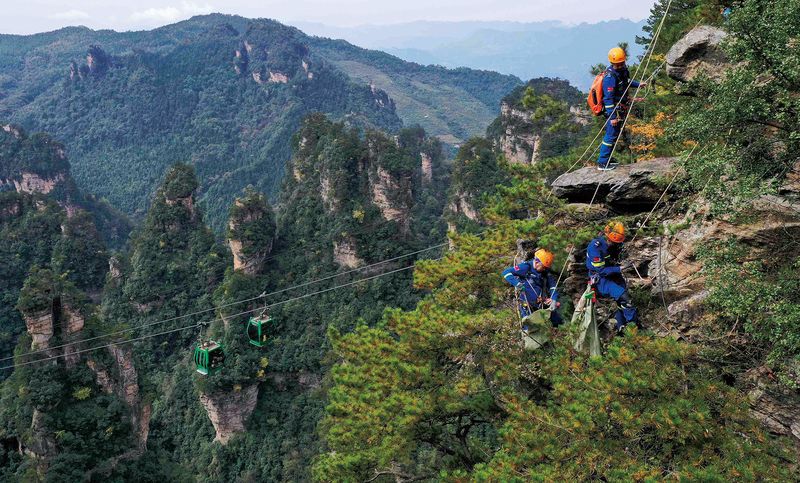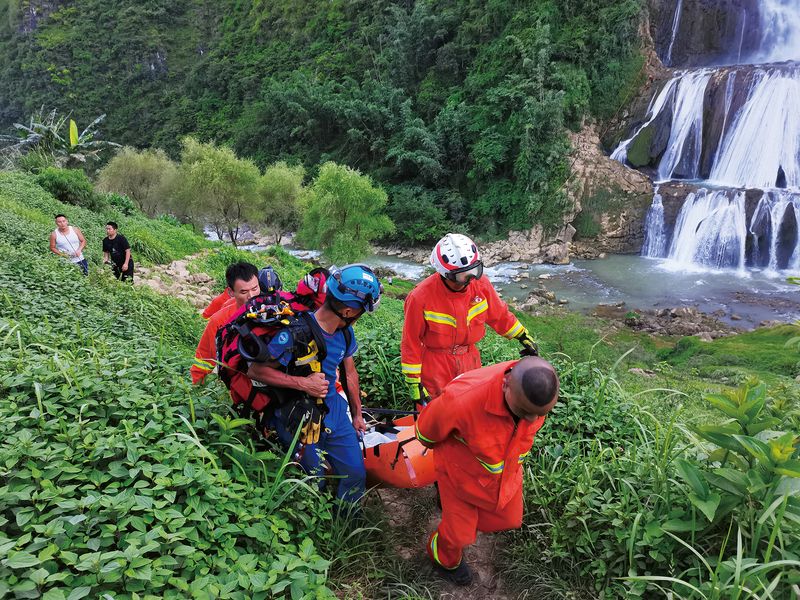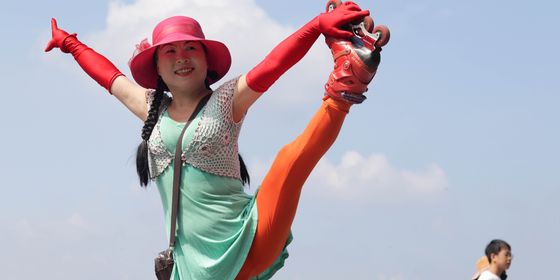Chinese are embracing outdoor sports, but safety measures fail to keep pace
It was when his tongue started to freeze in his mouth that the trail runner knew the end was near. When a participant of the Yellow River Stone Forest Park 100K, who blogs under the name “Liulang Nanfang,” realized this was happening to him, he quit the race and started to descend the mountain—and found with a growing dread that the way down is even harder than the climb up.
Slipping over rain-slicked rocks through a dense mist which obscured the path, he began to shiver uncontrollably. Eventually, as the window of his mind was reduced to a single thought—“I must get to the bottom of the mountain”—he spotted a team of rescuers through the fog, and was ushered out of the howling gale and into a small wooden hut with ten other runners, who huddled together until their trembling abated and they could descend on their own.
“Nanfang” was one of the lucky ones, as 21 of his fellow runners never made it back from the May 22 ultramarathon in Baiyin, Gansu province—what’s become known as the deadliest trail race in Chinese history. Poor planning, a lack of aid stations on the mountain, no rules making warm clothes mandatory, and a sudden hailstorm combined to create a catastrophic—and entirely preventable—tragedy.
The incident sent shockwaves through media in China and the world, with people in disbelief that even the most seasoned runners were not immune to tragedy out in the wild. After the initial expressions of sympathy and occasional lurid pictures of hypothermia victims, a sense of foreboding became apparent in groups of trail runners on messaging app WeChat. “The races will become more expensive and shittier. The golden age of trail running in China is dead,” lamented one runner. A few days after the disaster, the General Administration of Sports banned ultramarathons, mountain and desert races, and wingsuit flying across China, “pending reviews of the rules” governing these events.
The reactions to the events in Gansu are not surprising in the context of a public which has become more and more engaged with issues of outdoor safety. Since the NGO Chinese Mountaineering Association began collecting annual statistics in 2001, the number of serious accidents involving mountain climbers has risen every year, with 2,055 in 2019. The number of deaths and disappearances rose from just three in 2001 to 74 in 2019 (although this figure is confined only to leisure mountaineers, and does not include people working in outdoor environments or accidents in other outdoor sports).
China’s outdoor sports see exploding interest
These alarming trends come against a background of growing interest in outdoor sports. It is hard to get precise numbers on the number of people who participate in outdoor activities like camping and hiking, but one useful proxy might be domestic sales of outdoor sports products. According to a 2020 report by Beijing consulting firm Zhongjin Qixin, the industry saw a yearly growth rate of over 50 percent at the start of the 2010s, before falling to a more stable increase of just a few percent in the second half of the decade. Sanfo, one of China’s largest outdoor sports goods retailers and events organizers, turned over 486 million RMB in 2018.
Public opinions on outdoor activities have not always caught up with their popularity. In an article on trekking holidays in China Newsweek magazine last October, a travel writer under the name Ni Lao described trying to hike in a remote part of the country: “When hostel owners saw my walking sticks, they would always urge me not to go walking; and whenever I met forestry officials, they would try to scare me off by telling me about bears and wolves…In Chinese people’s eyes, hiking means you’re up to no good. The only right way to travel is to take a battery-powered car in a scenic area with the retired aunties and uncles.”
The general public’s reaction to news of lost hikers and outdoor-lovers are also usually unsympathetic, with comments castigating the victims as “spending money to suffer” and “causing trouble for the nation.” Mainstream media may follow with warnings for travelers to stay away from the wilderness and stick to “scenic areas.”
Local governments often resort to one-size-fits-all bans due to the risks. On Taibai Mountain in Shaanxi province, where more than 50 hikers have died over the years, the local government has issued repeated injunctions that the mountain simply should not be climbed. In some spots on the Great Wall popular with hikers, it’s common to find security guards employed by the local villages blocking the routes and turning away climbers.
A major problem has been the confusion over where responsibility lies for outdoor mishaps. China’s 2013 Tourism Law stipulates that “local governments and relevant departments and organizations” are responsible for rescuing tourists in the event of emergencies, but the details are up to the judges to define if the incident comes to court. Who pays the cost of these operations is also contentious: The Daocheng Yading Scenic Area in Sichuan province spends over 1 million RMB annually on searching for and rescuing stranded tourists, one of its officials told China News in July, and has started to charge reckless tourists a starting price of 15,000 RMB per rescue. Helicopter services can cost 40,000 RMB per hour.
Rather than bans, experienced hikers and outdoor educators suggest the government take responsibility in providing safer, more convenient ways for people to enjoy nature. “In terms of infrastructure, the main things which China needs to improve are its national park systems and its trail systems,” says Li Songtao, coordinator of an outdoor skills training program for children and adults in Shenzhen.
In many countries, trails are publicly maintained footpaths, usually covering rural and urban green areas, allowing the general public to access nature without interference from vehicles or landowners. Without such a resource, hikers in China must use paths left by local farmers and herders, or carve their own routes through the wilderness, leading to environmental damage, accidents due to lack of trail maintenance, and conflicts with locals. “We should study developed countries’ thinking about walking path systems, and also gain a deeper understanding of environmental protection,” says Li.
China is seeking to develop a national park system. However, this move may not necessarily improve people’s access rights, as many of the parks are built with conservation in mind. At the Changbaishan National Nature Reserve in the northeastern Jilin province, a prospective national park, concerns about tourists picking critically endangered wild ginseng means visitors are only allowed to walk along short designated pathways, with little chance to get off the tarmacked roads.
Apart from physical infrastructure, Li also suggests improving the public’s outdoor education to raise awareness of safety and their environmental footprint. China is not without its own tradition of outdoor pioneers: The second team to summit Mount Qomolangma (Everest), and the first to do so from the north slope, was a three-person Chinese team in 1960. Walking parts or all of the route of the “Long March,” the Red Army’s 12,500-kilometer retreat from Jiangxi to Shaanxi province in 1934 and 1935, is a staple of “red tourism” itineraries as well as commemorative events for the Communist Party.
However, the idea of mass participation in outdoor sports for leisure is more recent. “The problem is most people aren’t really familiar with the concept of outdoor and adventurous sports,” says Li. “Outdoor and exploration sports are a product of industrialization, but China has industrialized too fast, so many people haven’t had a chance to understand them yet.”
China's outdoor enthusiasts underestimate nature
Chen Pengbin, China’s first international ultramarathon champion, agrees. “Since China has opened up the last 40 years and people have more money, their need to stay healthy has also grown,” he tells TWOC. Chen grew up in a fishing community in Zhejiang province and began working on the boats at the age of 13, before discovering running through the growing number of easy-to-enter marathons held in cities all around China. He has since run on every continent, including Antarctica. “It’s not just in China. I attend a lot of international competitions, and wherever people have money, they start to think about health matters a lot,” Chen says.
But enthusiasm coupled with inexperience can lead to disaster outdoors. One prosaic—and perhaps surprising—source of accidents is photo-taking and visual culture, according to Zhao Heqiang, a local of a village in Beijing’s Miyun district who has been taking people out to explore unrestored sections of the Great Wall for 30 years. “One time I was taking a group from Hong Kong out to hike on the Wall. As we were coming back down, one member of the group, a university teacher, was walking and looking at photos [on her phone] at the same time, when she slipped and fell off the Wall! We had to call the fire department to bring her down on a stretcher.”
Another mistake even experienced outdoor-lovers are not immune from—including many who died in the Gansu marathon—is underestimating weather conditions and not bringing the appropriate clothing. “Once, in 2007, I got a call from two people out on the Wall who ran into a lightning storm, and I had to talk them out of panicking and explain that they should shelter and wait it out,” Zhao recalls.
Village locals and trip leaders like Zhao frequently find themselves the de facto first responders when accidents happen. Outdoor and disaster rescue services may be divided between the local police department, fire department, and even the military. In recent years, non-governmental rescue groups have become more and more active—Chen’s hometown of Taizhou alone reported that 26 such organizations registered with the Civil Affairs Bureau by October of 2019. Blue Sky Rescue, a non-profit organization founded in 2007, has 669 authorized rescue teams in 31 provincial-level regions and over 50,000 registered volunteers, including over 30,000 with professional rescue training and certification.
Local governments lacking in expertise and resources may hire organizations like Blue Sky to rescue stranded or injured visitors. However, rescuers lose valuable time due to the remote location and lack of advanced equipment at most accident sites, with fatal consequences. A Blue Sky team in Beijing’s Fangshan district estimated that most distress calls come from more than 40 kilometers away from their base. In July last year, when a falling rock struck three hikers on a mountain in the far west of Beijing, volunteers from Blue Sky and another NGO, Green Boat Emergency Rescue, drove up to four hours from the other side of the city, and spent several more hours climbing the mountain by foot, before finally reaching the accident site at 10 p.m.—tragically, one hiker had already died.
In Li’s classes, people of all ages study how to improve their navigation skills, weather preparedness, and learn basic first aid. His students include amateurs who start with basic courses on what clothes to wear outdoors, as well as serious mountaineers and mountain rescuers.
This is fortunate, because for the people who love the outdoors, there is no likelihood of giving up their hobby. Chen, after recovering from a serious foot injury in 2015, promptly gained sponsorship to do a run all the way from Guangzhou to Beijing—an epic 2,000-kilometer journey which he describes as his life’s biggest competitive achievement. “If I didn’t run, I never would have gotten to see so many of the places I’ve been to. There just wouldn’t be a reason to go to places if I didn’t do it to run,” he says.
Additional reporting by Tan Yunfei (谭云飞)
The Trails and Tribulations of China's Outdoors Boom is a story from our issue, “Call of the Wild.” To read the entire issue, become a subscriber and receive the full magazine.


















